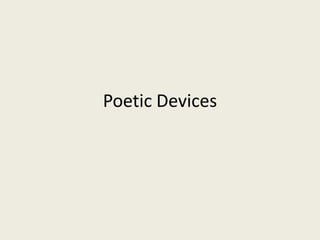
Poetic devices
- 2. Alliteration ALLITERATION: Repeating a consonant sound in close proximity to others, or beginning several words with the same vowel sound. For instance, the phrase "buckets of big blue berries" alliterates with the consonant b. The line "apt alliteration's artful aid" alliterates with the vowel sound a. Walt Whitman's "Song of Myself" employs the technique: "I lean and loaf at my ease observing a spear of summer grass." Most frequently, the alliteration involves the sounds at the beginning of words in close proximity to each other. If alliteration also involves changes in the intervening vowels between repeated consonants, the technique is called consonance.
- 3. CONSONANCE A special type of alliteration in which the repeated pattern of consonants is marked by changes in the intervening vowels--i.e., the final consonants of the stressed syllables match each other but the vowels differ. Examples include linger, longer, and languor or rider, reader, raider, and ruder. Do not confuse consonance with a consonant.
- 4. ASSONANCE Repeating identical or similar vowels (especially in stressed syllables) in nearby words. Assonance in final vowels of lines can often lead to half-rhyme. Deutsche notes that assonance is a common technique in the poetry of G. M. Hopkins, Dylan Thomasp, and more generally in popular ballads; an example appears in the second and fourth lines of this stanza from "Fair Annie": Bind up, bind up your yellow hair,And tie it on your neck;And see you look as maiden-likeAs the day that first we met. (qtd in Deutsche 140). If combined with consonnance, assonance can create actual full rhyme
- 5. REFRAIN A line or set of lines at the end of a stanza or section of a longer poem or song--these lines repeat at regular intervals in other stanzas or sections of the same work. Sometimes the repetition involves minor changes in wording. A refrain might consist of a nonsense word (such as Shakespeare's "With a hey, and a ho, and a hey nonino" in the song from As You Like It), a single word (such as “__________" in Poe's "The Raven"), or even an entire separate stanza that is repeated alternating with each stanza in the poem. If the refrain is meant to be sung by all the auditors listening, the refrain is often called a chorus. The device is ancient. Examples are found in the Egyptian Book of the Dead, the Bible, Greek, Latin, and Provençal verse, and in many, many ballads
- 6. RHYME SCHEME: The pattern of rhyme. The traditional way to mark these patterns of rhyme is to assign a letter of the alphabet to each rhyming sound at the end of each line. For instance, here is the first stanza of James Shirley's poem "Of Death," from 1659. I have marked each line from the first stanza with an alphabetical letter at the end of each line to indicate rhyme: The glories of our blood and state --------------AAre shadows, not substantial things; -----------BThere is no armor against fate; ------------------A Death lays his icy hand on kings: ---------------BScepter and crown -------------------------------CMust tumble down, --------------------------------CAnd in the dust be equal made ------------------D With the poor crooked scythe and spade. -----D
- 7. INTERNAL RHYME: A poetic device in which a word in the middle of a line rhymes with a word at the end of the same metrical line. Internal rhyme appears in the first and third lines in this excerpt from Shelley's "The Cloud": I silently laugh at my own cenotaph,And out of the caverns of rain,Like a child from the womb, like a ghost from the tomb, I arise and unbuild it again. In the excerpt above, the word laugh is an internal rhyme with cenotaph, and the word womb is an internal rhyme with tomb. Other examples include the Mother Goose rhyme, "Mary, Mary, quite contrary," or Coleridge's Ancient Mariner, ("We were the first that ever burst / Into that silent sea"). Contrast with interlaced rhyme, above.
- 8. ONOMATOPOEIA The use of sounds that are similar to the noise they represent for a rhetorical or artistic effect. For instance, buzz, click, rattle, and grunt make sounds akin to the noise they represent. A higher level of onomatopoeia is the use of imitative sounds throughout a sentence to create an auditory effect. For instance, Tennyson writes in The Princess about "The moan of doves in immemorial elms, / And murmuring of innumerable bees." All the /m/ and /z/ sounds ultimately create that whispering, murmuring effect Tennyson describes. In similar ways, poets delight in choosing sounds that match their subject-matter, such as using many clicking k's and c's when describing a rapier duel (to imitate the clack of metal on metal), or using many /s/ sounds when describing a serpent, and so on.
- 9. ONOMATOPOEIA (a higher level) Robert Browning liked squishy sounds when describing squishy phenomena, and scratchy sounds when describing the auditory effect of lighting a match, such as in his poem "Meeting at Night": "As I gain the cove with pushing prow, / And quench its speed i' the slushy sand. / a tap at the pane, the quick sharp, scratch / and blue spurt of a lighted match." The technique is ancient, and we can find a particularly cunning example in Virgil's Latin, in which he combines /d/ and /t/ sounds along with galloping rhythm to mimic in words the sound of horses he describes: "Quadrupedanteputremsonituquatit ungula campum. . . ."